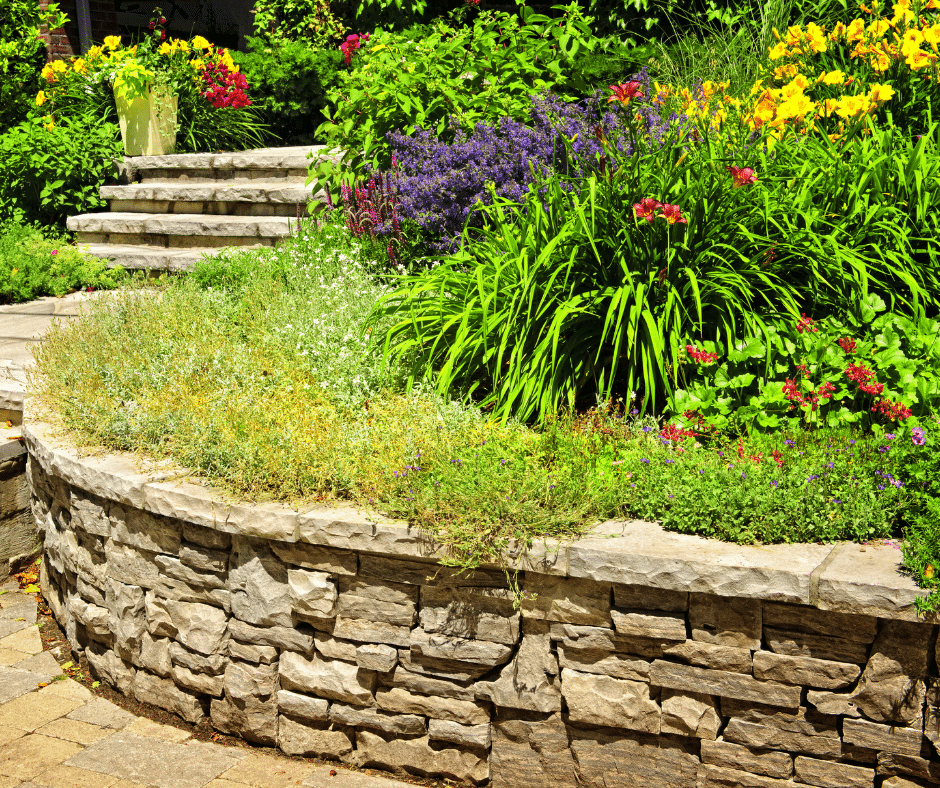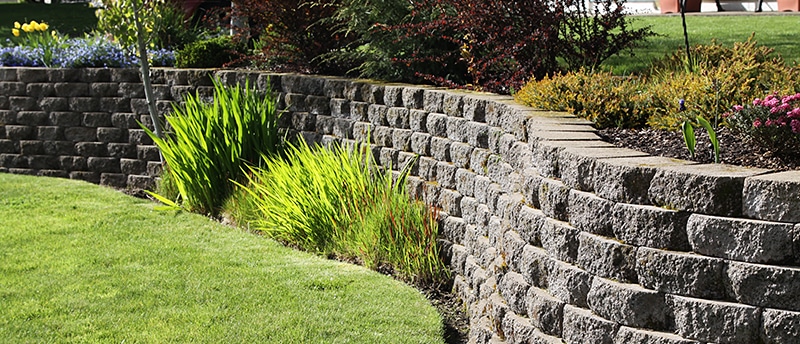How OKC Precision Retaining Walls prevent erosion and transform sloped landscapes
How OKC Precision Retaining Walls prevent erosion and transform sloped landscapes
Blog Article
Secret Considerations for Building Efficient Retaining Walls in Your Yard
When you're considering developing a preserving wall surface in your lawn, it's crucial to consider numerous vital variables. The wall surface's purpose, the products you'll utilize, and the specific dirt problems can all impact its effectiveness and long life. You'll likewise require to browse regional building ordinance and strategy for appropriate drainage. However how do you ensure your design not just meets these needs however likewise boosts your landscape? Allow's discover the essential steps with each other.
Recognizing the Purpose of Your Retaining Wall
When you consider developing a retaining wall, consider its main purpose: stabilizing dirt and stopping erosion. Retaining walls supply important assistance for sloped landscapes, helping to keep dirt honesty. You'll find they're important in areas where water drainage may or else remove dirt, bring about pricey repair services and landscape damages.
By keeping back planet, these walls create level surface areas for gardens, patios, or pathways. This not only enhances your yard's aesthetics however also advertises far better drainage, lowering water merging in unwanted locations. If you're handling high slopes, a well-constructed retaining wall surface can prevent landslides, making certain safety for you and your residential or commercial property.
Inevitably, comprehending the purpose of your retaining wall surface will lead your layout choices and help you develop a useful, durable structure that satisfies your requirements. So, take a moment to review your landscape; it'll pay off in the future.
Selecting the Right Materials
When selecting materials for your retaining wall surface, you'll wish to think about toughness, looks, and expense. Each aspect plays an important duty in guaranteeing your wall stands the examination of time while looking excellent and fitting your budget. Allow's explore exactly how to make the most effective options for your project.
Product Toughness Variables
Selecting the best materials is essential for the durability and effectiveness of your retaining wall surface, because their resilience straight influences the wall's capacity to endure ecological anxieties. Start by considering your local climate; products like concrete and stone stand up to moisture and temperature level variations well. If you live in an area vulnerable to heavy rainfalls, select products with great water drainage homes, like crushed rock or porous blocks, to stop water accumulation.
Some materials perform better in details dirt kinds, so it's crucial to match them appropriately. Choosing long lasting materials warranties your retaining wall surface stands solid, shielding your yard for years to come.
Visual Design Choices
Durable products not just ensure your retaining wall's structural stability yet additionally play a vital role in its visual appeal. When choosing the appropriate products, think concerning how they complement your landscape. All-natural rock offers a classic, rustic appearance, while concrete blocks can give a streamlined, contemporary surface. You may likewise take into consideration utilizing timber for a cozy, natural feel. Color and appearance matter, as well; choose tones that harmonize with your home and yard. Do not ignore the wall surface's form-- curved walls can create a softer look, while straight lines can really feel much more organized. By thoroughly selecting products that line up with your aesthetic vision, you'll improve your outdoor room while ensuring your wall stands solid versus the elements.
Cost-Effectiveness Evaluation
Selecting the right products for your retaining wall isn't practically visual appeals; it's also essential for your budget plan. When choosing materials, take into consideration both ahead of time costs and lasting durability. Concrete blocks might be more expensive originally, but their long life can save you money on repair work. On the other hand, hardwood can be much more budget-friendly yet may require replacement quicker.
Do not forget to variable in maintenance costs. Some products, like all-natural rock, can add appeal and need less maintenance, while others might need regular treatments
Eventually, consider the pros and disadvantages of each alternative versus your budget plan and the wall's desired purpose. Spending intelligently in materials currently can avoid pricey issues down the road. Select products that stabilize expense and efficiency efficiently.
Assessing Soil Problems and Drain
As you begin your job, evaluating dirt problems and drainage is crucial for the success of your retaining wall. Start by checking out the kind of dirt in your lawn. Sandy soil drains well but does not have stability, while clay dirt can maintain wetness, resulting in push on your wall. Check the soil's wetness web content by digging a small hole and observing how rapidly it dries.
Next, analyze the slope of your yard. If water visit this website naturally flows towards your wall, you'll need to execute a drainage service to prevent disintegration and stress accumulation. Think about setting up perforated pipes or gravel backfill behind the wall surface to facilitate drainage.
Finally, observe any type of close-by trees or plant life; their roots can impact dirt security. By recognizing your soil problems and implementing appropriate drainage, you'll produce a strong structure for your retaining wall surface that stands the examination of time.
Adhering To Local Building Ordinance
Before you begin building your retaining wall surface, you require to research study local policies to ensure compliance. It's necessary to recognize what allows you should acquire, as this can save you from costly penalties or needing to remodel your job. Taking these steps seriously will aid you develop a risk-free and effective structure.
Research Local Laws
Understanding neighborhood guidelines is essential when planning your retaining wall project, particularly considering that building codes can vary significantly by place. Look for standards on wall surface height, products, water drainage systems, and structural integrity. By doing your study upfront, you can guarantee your retaining wall surface fulfills all essential codes and blends effortlessly right into your yard.
Obtain Necessary Licenses
When you have actually looked into neighborhood policies, the following step is to acquire the necessary licenses for your retaining wall surface project. They might need certain strategies or design analyses, especially for bigger walls. Securing the right authorizations can save you from costly penalties or having to dismantle your wall surface later.

Planning the Design and Aesthetic Appeal
As you start planning the layout and aesthetic appeals of your retaining wall surface, think about just how it will harmonize with the surrounding landscape. Think of the materials you'll utilize-- stone, block, or concrete-- and how they'll enhance your home's design and the natural environments in your backyard. Pick shades and textures that blend flawlessly with existing attributes like patios, pathways, or yards.
Next, picture the wall surface's form and elevation. Rounded walls can soften a stiff landscape, while straight lines might convey a more modern-day appearance. Don't neglect to integrate plants and greenery around the wall for a natural touch; this can improve its charm and incorporate it right into the atmosphere.
Lastly, keep in mind performance. Your design needs to not just be aesthetically pleasing but likewise offer its function successfully. By attentively preparing these components, you'll develop a keeping wall that improves your yard's beauty while fulfilling its architectural function.
Computing Elevation and Density Needs
To develop a strong retaining wall surface, you need to precisely calculate its elevation and thickness demands based upon the dirt problems and the height of the slope it will support. Begin by assessing the incline's angle and the sort of dirt, as different soils exert differing amounts of pressure.
For walls over 4 feet high, think about a density of at the very least 12 inches. If the wall is taller, raise the thickness proportionally to preserve security.
Following, compute the height of the wall surface by determining the vertical distance it requires to maintain. For each foot of height, you need to commonly prepare for a density of one-third of the wall's elevation.
Constantly bear in mind to account for extra factors like water drainage and backfill, which can influence your wall surface's design. Appropriate estimations currently assure your retaining wall surface stands strong and lasts for several years to find.
Maintenance and Long Life Considerations
While keeping your retaining wall surface might look like a reduced top priority, disregarding it can lead to substantial issues with time. Routine examinations are Discover More Here important; look for splits, protrudes, or any kind of indications of water damages. Dealing with these troubles early can conserve you from pricey repairs later on.
Maintain an eye on drainage systems, too. Blocked drains can cause water to construct up, putting in pressure on your wall and compromising its security. Clear debris and warranty proper flow to maintain longevity.
You might also wish to review sealing your wall to secure it from moisture and weathering. Relying on the material, this may need reapplication every few years.
Finally, landscaping around your wall can sustain its honesty. Stay clear of planting huge trees close by, as their roots can undermine the foundation. With positive maintenance, your retaining wall surface can serve you well for years to come.

Regularly Asked Concerns
Can I Build a Retaining Wall by Myself, or Should I Work with a Professional?
You can most definitely build a preserving wall yourself if you have the right tools and understanding. Nonetheless, hiring a specialist warranties it's done properly, particularly for larger or even more intricate frameworks. Consider your skill level before deciding.
What Are one of the most Usual Errors Made When Building Retaining Walls?
When constructing retaining walls, you may ignore correct drainage, skip making use of the right materials, or disregard support. These typical errors can bring about architectural failing, so take your time and plan thoroughly to avoid issues.
Exactly how Do I Know if My Retaining Wall Needs Support?
You'll recognize your retaining wall surface needs reinforcement check this if you see fractures, leaning, or bulging. Look for water pooling behind it or soil erosion near the base. Address these signs promptly to avoid additional damage.
What Plant kingdom Are Ideal for Landscaping Around a Retaining Wall?
When landscaping around a keeping wall, think about making use of low-maintenance plants like succulents, ornamental yards, or creeping ground covers - OKC Precision Retaining Walls. They'll grow in those problems and include appeal while avoiding soil disintegration around your wall surface
Just How Can I Avoid Disintegration Around My Retaining Wall?
To stop disintegration around your retaining wall surface, you can plant ground cover, use compost, and mount water drainage systems. Regularly inspect for water accumulation and readjust landscaping to redirect overflow away from the wall surface.
Report this page